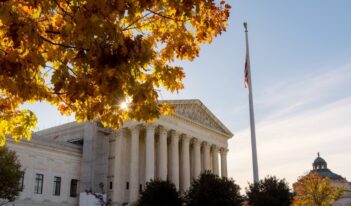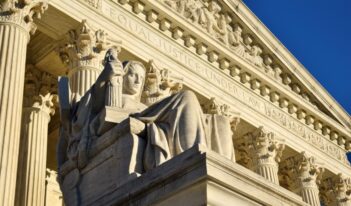
Judge Kavanaugh’s past opinions reveal a commitment to clarifying deference rules and increasing predictability.
Discussion of Judge Brett Kavanaugh’s nomination to the U.S. Supreme Court has focused on doctrines of deference to administrative decisions. Despite some hypertensive rhetoric around these issues, there is little to get excited about, unless you are looking for greater clarity in the law.
At their best, deference doctrines reflect constitutional basics, precedent, and statutory directions. The Founding Fathers designed the U.S. Constitution’s structural provisions to prevent any official or governmental body from exercising too much unchecked discretionary power. Thus, the U.S. Congress writes laws, the executive branch implements them, and judges resolve concrete disputes, including disputes about specific applications of law.
In deciding cases about administrative actions, judges determine the meaning of the law, but where the law gives constitutionally permitted discretion to an official, judges defer to the official’s judgment, checking for abuse of discretion rather than substituting judgment on the “right” decision. Chief Justice John Marshall made that point in the early 1800s, and courts largely stuck with that understanding ever since.
The Administrative Procedure Act (APA) of 1946, codifying, clarifying, and (in some respects) amending generally applicable rules for federal administrative process, followed this same formula. It provided that judicial review was limited to the extent that laws committed matters to agency discretion, but also directed that reviewing courts “shall decide all relevant questions of law, interpret constitutional and statutory provisions, and determine the meaning and applicability of the terms of agency action.”
The Supreme Court’s 1984 decision, Chevron v. Natural Resources Defense Council, interpreted language from the Clean Air Act (CAA) mirroring the APA. The Court rejected a challenge to a U.S. Environmental Protection Agency (EPA) decision on how to regulate pollution from “stationary sources”—specifically, on what size unit that term should cover—as a policy choice within agency discretion under the CAA, a reasonable exercise of legally delegated authority that did not violate the terms of the CAA.
Unfortunately, Justice John Paul Stevens framed the Court’s reasoning in confusing language, trying to account for the observation that unclear instructions from Congress often convey discretion to those charged with their implementation. Though the justices believed they were clarifying existing law, Justice Stevens’s language led some judges and scholars to conclude that Chevron commanded deference to EPA’s interpretation of the law, not to its discretionary policy choice permitted by the law.
The opinion attempted to clarify its consistency with prior law—and, implicitly, the terms of the CAA and APA—by noting that courts are “the final authority on issues of statutory construction” and should reject administrative decisions that violate what courts, “using traditional tools of statutory construction,” decide the law means. The damage, however, was done.
This language resulted in almost 35 years of arguments over exactly what test Chevron mandates, how that test fits with the APA, and whether it applies to all administrative decisions or only to a subset of them. Scholars differ on whether Chevron produced more deference to administrators, but it surely did not increase judicial review’s predictability, nor have the Court’s efforts to reformulate or supplement Chevron. Many commentators, of all political persuasions and methodological commitments, including former Chevron defenders, have concluded that Chevron sometimes has generated too much deference, sometimes too little, and much uncertainty.
If Chevron was a defensible but confusing effort at statutory construction, the Supreme Court’s 1997 decision in Auer v. Robbins was an indefensible muddle. This unanimous opinion commanded courts to accept any reasonable construction administrators give agency rules. Chevron can be defended as recognizing Congress’s power to decide (within limits) executive officers’ discretionary authority. But no similar power exists for executive officers to decide how much to expand their own authority. Earlier deference declarations cited in Auer misled the Court: They effectively granted “deference” when the Court agreed with the agency’s reading of the rule and other factors—including statutory support—favored deferring. Auer, too, has come under attack, even from the decision’s author.
Judge Kavanaugh’s appointment should help, not hurt, better formulation of deference rules. His engagement with deference is substantial, clearly articulated, and solidly within the mainstream of scholarly discourse and judicial decisions.
Judge Kavanaugh clearly understands that judges should not merely be guided but bound by constitutional and statutory command. His article reviewing, commenting on, and jumping off from Judge Robert A. Katzmann’s book on statutory interpretation, grounds analysis of deference issues (and statutory construction overall) in constitutional structure and the judge’s properly limited role. Kavanaugh emphasizes reducing judicial discretion and official discretion more generally, seeking methodologies to guide interpretation that yield more predictable outcomes regardless of which judge decides.
Focusing on Chevron, Judge Kavanaugh objects that its test lets judges choose when to intervene and when to defer to administrators, fails to cabin either the judges’ or the administrators’ discretion predictably, and ignores the statutory texts that should control judicial review standards. At times, judges invoking Chevron avoid critical interpretive decisions. Those objections parallel complaints of well-respected scholars and judges, liberal and conservative.
Judge Kavanaugh understands that Congress often grants discretion to agencies, that sometimes vague directions signal that authorization, but also that courts should say when and how far statutes grant that discretion. He understands, too, that judicial construction of laws must be sensitive to structural realities—including the point Justice Antonin Scalia captured in the adage, “Congress…does not…hide elephants in mouseholes.” In other words, Congress is especially unlikely to confer deference on agencies to make major changes in the law without saying so clearly.
These views will make Justice Kavanaugh—even more than Judge Kavanaugh, who has less control over precedent—likely to anchor deference rules in statutory text rather than Chevron’s or Auer’s interpretive rules. If that approach becomes the Court’s norm, it may not change the amount of discretion exercised by administrators, but it could clarify the law on how Congress grants discretionary authority and how judges do their jobs. That prospect should be applauded, not feared.
This essay is part of a series entitled Judge Kavanaugh and Administrative Law.




